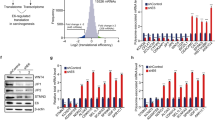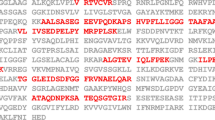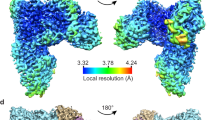Abstract
The PDZ proteins such as hDLG, hScrib and MAGIs function as the membrane-associated protein scaffolds and have been shown to interact with the high-risk human papillomavirus (HPV) E6s. In this report, we identify a Golgi-associated PDZ protein, cystic fibrosis transmembrane regulator-associated ligand (CAL) as a cellular target of HPV16 E6 by the proteomic approach. The carboxy-terminal PDZ-binding motif of HPV16 E6 specifically interacts with the PDZ domain of CAL, and the interaction enhances proteasome-mediated degradation of CAL. HPV16 E6 interacts with CAL more strongly and degrades it better than HPV18 E6 owing to the more compatible PDZ-binding motif. CAL is ubiquitinated by the E6/E6-associated protein (E6AP) complex or by E6AP alone, albeit less efficiently, which indicates that it could be a normal target of E6AP. Although it downregulates CAL at the transcript level, small interfering RNA-induced depletion of HPV16 E6 in Caski cells stabilizes CAL at the protein level, suggesting that HPV16 E6 mediates the proteasomal degradation of CAL in HPV-positive cervical cancer cells. HPV16 E6 may tightly regulate the vesicular trafficking processes by interacting with CAL, and such a modification can contribute to the development of cervical cancer.
This is a preview of subscription content, access via your institution
Access options
Subscribe to this journal
Receive 50 print issues and online access
$259.00 per year
only $5.18 per issue
Buy this article
- Purchase on Springer Link
- Instant access to full article PDF
Prices may be subject to local taxes which are calculated during checkout







Similar content being viewed by others
References
Butz K, Ristriani T, Hengstermann A, Denk C, Scheffner M, Hoppe-Seyler F . (2003). Oncogene 22: 5938–5945.
Charest A, Lane K, McMahon K, Housman DE . (2001). J Biol Chem 276: 29456–29465.
Cheng J, Moyer BD, Milewski M, Loffing J, Ikeda M, Mickle JE et al. (2002). J Biol Chem 277: 3520–3529.
Cheng J, Wang H, Guggino WB . (2004). J Biol Chem 279: 1892–1898.
Chiang SH, Baumann CA, Kanzaki M, Thurmond DC, Watson RT, Neudauer CL et al. (2001). Nature 410: 944–948.
Cuadra AE, Kuo SH, Kawasaki Y, Bredt DS, Chetkovich DM . (2004). J Neurosci 24: 7491–7502.
Gao Q, Kumar A, Singh L, Huibregtse JM, Beaudenon S, Srinivasan S et al. (2002). Cancer Res 62: 3315–3321.
Gentzsch M, Cui L, Mengos A, Chang XB, Chen JH, Riordan JR . (2003). J Biol Chem 278: 6440–6449.
Glaunsinger BA, Lee SS, Thomas M, Banks L, Javier R . (2000). Oncogene 19: 5270–5280.
Graham FL, van der Eb AJ . (1973). Virology 52: 456–467.
Grassmann K, Rapp B, Maschek H, Petry KU, Iftner T . (1996). J Virol 70: 2339–2349.
Hassel B, Schreff M, Stube EM, Blaich U, Schumacher S . (2003). J Biol Chem 278: 40136–40143.
Hengstermann A, Linares LK, Ciechanover A, Whitaker NJ, Scheffner M . (2001). Proc Natl Acad Sci USA 98: 1218–1223.
Huibregtse JM, Scheffner M, Howley PM . (1993). Mol Cell Biol 13: 775–784.
Humbert P, Russell S, Richardson H . (2003). Bioessays 25: 542–553.
Jiang M, Milner J . (2002). Oncogene 21: 6041–6048.
Kanda T, Watanabe S, Zanma S, Sato H, Furuno A, Yoshiike K . (1991). Virology 185: 536–543.
Kao WH, Beaudenon SL, Talis AL, Huibregtse JM, Howley PM . (2000). J Virol 74: 6408–6417.
Kelley ML, Keiger KE, Lee CJ, Huibregtse JM . (2005). J Virol 79: 3737–3747.
Kiyono T, Hiraiwa A, Fujita M, Hayashi Y, Akiyama T, Ishibashi M . (1997). Proc Natl Acad Sci USA 94: 11612–11616.
Kubbutat MH, Jones SN, Vousden KH . (1997). Nature 387: 299–303.
Kuhne C, Banks L . (1998). J Biol Chem 273: 34302–34309.
Kumar S, Talis AL, Howley PM . (1999). J Biol Chem 274: 18785–18792.
Lee SS, Glaunsinger B, Mantovani F, Banks L, Javier RT . (2000). J Virol 74: 9680–9693.
Lee SS, Weiss RS, Javier RT . (1997). Proc Natl Acad Sci USA 94: 6670–6675.
Mantovani F, Banks L . (2001). Oncogene 20: 7874–7887.
Nakagawa S, Huibregtse JM . (2000). Mol Cell Biol 20: 8244–8253.
Nakagawa S, Watanabe S, Yoshikawa H, Taketani Y, Yoshiike K, Kanda T . (1995). Virology 212: 535–542.
Neudauer CL, Joberty G, Macara IG . (2001). Biochem Biophys Res Commun 280: 541–547.
Pim D, Thomas M, Javier R, Gardiol D, Banks L . (2000). Oncogene 19: 719–725.
Piserchio A, Fellows A, Madden DR, Mierke DF . (2005). Biochemistry 44: 16158–16166.
Scheffner M, Werness BA, Huibregtse JM, Levine AJ, Howley PM . (1990). Cell 63: 1129–1136.
Schneider-Gadicke A, Kaul S, Schwarz E, Gausepohl H, Frank R, Bastert G . (1988). Cancer Res 48: 2969–2974.
Schneider-Gadicke A, Schwarz E . (1986). EMBO J 5: 2285–2292.
Sedman SA, Barbosa MS, Vass WC, Hubbert NL, Haas JA, Lowy DR et al. (1991). J Virol 65: 4860–4866.
Sheng M, Sala C . (2001). Annu Rev Neurosci 24: 1–29.
Smotkin D, Wettstein FO . (1986). Proc Natl Acad Sci USA 83: 4680–4684.
Thomas M, Banks L . (1998). Oncogene 17: 2943–2954.
Thomas M, Glaunsinger B, Pim D, Javier R, Banks L . (2001). Oncogene 20: 5431–5439.
Thomas M, Laura R, Hepner K, Guccione E, Sawyers C, Lasky L et al. (2002). Oncogene 21: 5088–5096.
Thomas M, Massimi P, Navarro C, Borg JP, Banks L . (2005). Oncogene 24: 6222–6230.
Yao R, Ito C, Natsume Y, Sugitani Y, Yamanaka H, Kuretake S et al. (2002). Proc Natl Acad Sci USA 99: 11211–11216.
Yao R, Maeda T, Takada S, Noda T . (2001). Biochem Biophys Res Commun 286: 771–778.
Yoshinouchi M, Yamada T, Kizaki M, Fen J, Koseki T, Ikeda Y et al. (2003). Mol Ther 8: 762–768.
Yue Z, Horton A, Bravin M, DeJager PL, Selimi F, Heintz N . (2002). Neuron 35: 921–933.
Zimmermann H, Degenkolbe R, Bernard HU, O'Connor MJ . (1999). J Virol 73: 6209–6219.
zur Hausen H . (1996). Biochim Biophys Acta 1288: F55–F78.
zur Hausen H . (2000). J Natl Cancer Inst 92: 690–698.
Acknowledgements
We thank Dr Jie Cheng for providing the human CAL cDNA and Dr Peter M Howley for the kind gift of HA-ub, E6AP and UbcH7 cDNAs. This work was supported by the Korea Science and Engineering Foundation through the Protein Network Research Center at Yonsei University.
Author information
Authors and Affiliations
Corresponding author
Additional information
Supplementary Information accompanies the paper on the Oncogene website (http://www.nature.com/onc).
Supplementary information
Rights and permissions
About this article
Cite this article
Jeong, K., Kim, HZ., Kim, S. et al. Human papillomavirus type 16 E6 protein interacts with cystic fibrosis transmembrane regulator-associated ligand and promotes E6-associated protein-mediated ubiquitination and proteasomal degradation. Oncogene 26, 487–499 (2007). https://doi.org/10.1038/sj.onc.1209837
Received:
Revised:
Accepted:
Published:
Issue Date:
DOI: https://doi.org/10.1038/sj.onc.1209837
Keywords
This article is cited by
-
Human papillomavirus E6 and E7 oncoproteins as risk factors for tumorigenesis
Journal of Biosciences (2009)
-
Human papillomaviruses, cervical cancer and cell polarity
Oncogene (2008)



